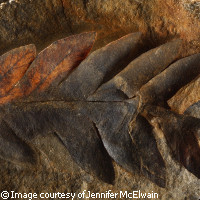Climate change linked to ancient mass extinction
A massive extinction event that took place 200 million years ago may have been caused by climate change, new research suggests. The findings shed new light on the pace of mass extinction, and imply that relatively small changes in atmospheric carbon dioxide levels may be enough to trigger an extinction event. The study, partly funded with a Marie Curie mobility grant from the EU's Sixth Framework Programme (FP6), is published in the latest edition of the journal Science. The Triassic-Jurassic extinction event is one of five mass extinction milestones in the Earth's history. At that time, many marine species died out and the first dinosaurs appeared. Scientists previously thought that mass extinctions occurred rather slowly, over millions of years. In this study, scientists from Ireland, the UK and the US studied six groups of fossilised plants found at the Kap Stewart Group site in eastern Greenland. They applied a new analysis technique to the rocks to see what was going on before and during the mass extinction event. Their investigations revealed that there were warning signs that the ecosystems were in decline long before species started to become extinct. During the period studied, both the number of plant communities and the number of individual plants fell. 'The abrupt plant diversity loss [...] is consistent with expected plant responses to a catastrophically rapid rather than gradual environmental change,' the researchers write. 'The differences in species abundances for the first 20 metres of the cliffs from which the fossils were collected are of the sort you can expect,' commented Peter Wagner of the Smithsonian Institution National Museum of Natural History in the US. 'But the final 10 metres show dramatic losses of diversity that far exceed what we can attribute to sampling error: the ecosystems were supporting fewer and fewer species.' Furthermore, the decline in the ancient plant communities coincided with a rise in carbon dioxide levels and global warming. However, the scientists note that higher sulphur dioxide levels from volcanic eruptions could also have played a role in the extinction event. 'We have no current way of detecting changes in sulphur dioxide in the past, so it's difficult to evaluate whether sulphur dioxide, in addition to a rise in carbon dioxide, influenced this pattern of extinction,' said Jennifer McElwain of University College Dublin in Ireland. Other possible causes of the extinction event include a meteorite and a massive release of methane. Nevertheless, we should learn from what happened in the past, the scientists warn. 'We must take heed of the early warning signs of deterioration in modern ecosystems,' stated Dr McElwain. 'We've learned from the past that high levels of species extinctions - as high as 80% - can occur very suddenly, but they are preceded by long intervals of ecological change.' Scientists now need good records of ancient carbon dioxide and sulphur dioxide levels to find out more accurately what happened 200 million years ago.
Countries
Ireland, United Kingdom, United States



